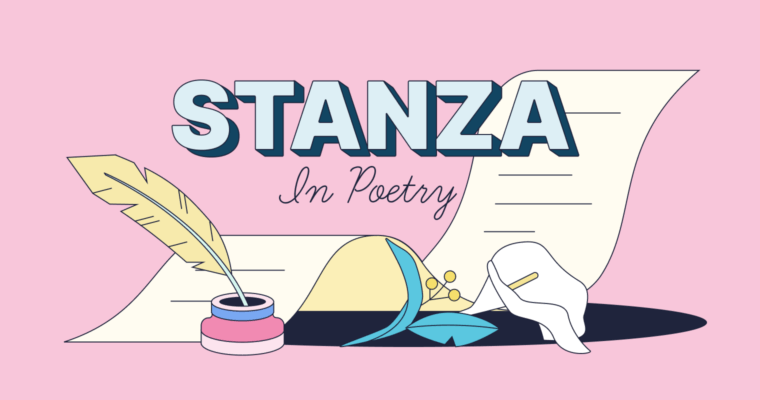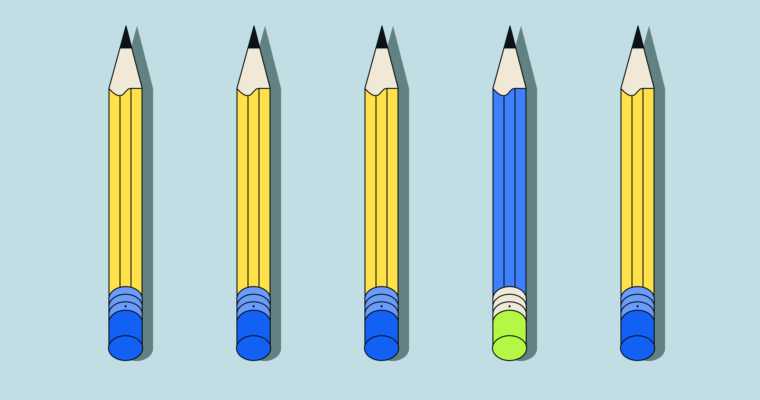
One of the most exciting and most daunting things about learning to write poetry is how many rules there are. There are so many types of poems that it may feel overwhelming at first. The best way to get started is to break down poetry into its building blocks, one of which is the stanza. A stanza is a group of lines that are read together, usually united around a common theme or idea.
What is a stanza in poetry?
Put simply, a stanza is a unit of lines in poetry. Just like we use paragraphs in prose, and verses in songs, stanzas are units that give a poem structure. They guide the reader from one idea to the next.
There are no rules about how many stanzas are in a poem. A poem can consist of a single stanza or make up an entire book full of stanzas. It all depends on how many stanzas are needed to convey the poem’s idea, message, or feeling.
How are stanzas structured?
The structure of a stanza is determined by the number of lines, the meter (the way syllables are stressed in each line), and the rhyme scheme.
Number of lines: Stanzas can have any number of lines. You may have heard words such as quatrain or octave used to describe a poem. Those words count the number of lines in each stanza. We’ll discuss the different names for stanzas below, but know that a stanza can be as long as a single line or an entire book.
Meter: Meter is a significant part of generating rhythm in a poem. This is the way syllables are stressed within each line. A classic meter in poetry is iambic pentameter, a ten-syllable line with a stress on every other syllable (it sounds like da-DUM da-DUM da-DUM da-DUM da-DUM).
Rhyme scheme: Rhyme schemes are the patterns of lines that rhyme. Rhyme schemes are typically written using letters, as in ABCB (where the Bs rhyme with each other) or ABAB (where the As rhyme with each other and the Bs rhyme with each other).
Why are stanzas important?
Stanzas are used to create structure. Without stanzas, a poem may become overwhelming or unruly, and as a result, its reader may feel lost. Stanzas also provide rhythm, organization, emotional shifts, and shape.
Structure: The main purpose of stanzas is to provide structure. They are the pillars that support your poem. This support is made up of the number of lines in each stanza, the rhyme scheme, and the meter.
Rhythm: Poetry is an inherently rhythmic form of reading and writing. By using a specific style of stanza, the poem develops a rhythm.
Organization: Stanzas group similar ideas and thoughts together. Well-organized stanzas create a path for the reader to move from one idea to the next.
Shifts: Stanzas are separated by line breaks on a page. This can provide respite, allowing room for a reader to pause and shift into a new idea or emotion.
Shape: One of the unique characteristics of poetry is its physical shape on a page. It can be straight up and down, it can twist and turn, it can hide in a corner, or it can fill an entire page. Designing your stanzas also means designing the way they will look on a page.
Stanza vs. verse
The word verse in poetry has multiple meanings, so the difference between stanza and verse changes depending on which verse we’re using.
To reiterate: A stanza is a distinct set of lines in a poem.
A verse can mean a single, metrical line in a poem; a group of lines (also known as a stanza); or an entire poem.
Of course, verse is also used to describe a distinct set of lyrics in music. This is, confusingly, the same meaning as stanza in poetry.
In short, a stanza is a distinct group of lines in a poem. A verse is any metrical unit of poetry—whether a single line or the entire poem—and can also be used to differentiate between poetry and prose.
What are the different types of stanzas?
There are many types of stanzas. Often they are grouped together by how many lines are in the stanza, but they can also be grouped by the length of their lines or their meters. Here are eleven common terms you might find when talking about stanzas.
1 Ballad: A ballad stanza is a four-line stanza with alternating meters. The first and third lines are typically tetrameter (four metrical feet) and the second and fourth lines are typically trimeter (three metrical feet).
Ballad stanzas are often written to be passed down orally, so you will hear the ballad stanza in many traditional folk songs and stories.
2 Couplet: A couplet is a pair of rhyming lines, one after the other, that together form a full grammatical thought.
3 Heterometric: A heterometric stanza is any stanza that contains lines of various lengths.
4 Isometric: An isometric stanza is any stanza that contains lines of the same length.
5 Monostich: A monostich is a stanza that comprises a single line. Occasionally, a poet will take on the incredible challenge of creating a monostich poem, in which a single line (and its title) is the entire poem.
6 Tercet: a stanza with three lines.
7 Quatrain: a stanza with four lines.
8 Quintrain: a stanza with five lines.
9 Sestet: a stanza with six lines.
10 Septet: a stanza with seven lines.
11 Octave: a stanza with eight lines.
Do you spot the pattern? There are many ways to mix and match these stanzas (for example, a four-line stanza designed to be passed down orally could be called a ballad quatrain). If you understand this list, then you are already beginning to understand how poetry is made.
Stanza examples
Ballad
Water, water, every where, And all the boards did shrink; Water, water, every where, Nor any drop to drink. —“The Rime of the Ancient Mariner” by Samuel Taylor Coleridge
Monostich
WINTER More time is spent at the window. —“30 One Liners” by Joe Brainard
1. How many hands have touched this food? —“44 Questions to Ask While Bingeing” by Kemi Alab
Couplet
The ladies men admire, I’ve heard, Would shudder at a wicked word. —“Interview” by Dorothy Parker
Tercet
Do not go gentle into that good night, Old age should burn and rave at close of day; Rage, rage against the dying of the light. —“Do Not Go Gentle Into That Good Night” by Dylan Thomas
We are things of dry hours and the involuntary plan, Grayed in, and gray. “Dream” makes a giddy sound, not strong Like “rent,” “feeding a wife,” “satisfying a man.” —“Kitchenette Building” by Gwendolyn Brooks
Quatrain
Whose woods these are I think I know. His house is in the village though; He will not see me stopping here To watch his woods fill up with snow. —“Stopping by Woods on a Snowy Evening” by Robert Frost
Quintrain
The stillness you prize. Won’t prize you back. Two beefsteaks. Ripening on a windowsill. A purple tray. Piled with coal. —“Pilgrim Bell” by Kaveh Akbar
Heterometric
The sun is still down and maybe even downer. Two owls, one white and one large-eared, dive into nothingness that is a field, night-beast in the swoop-down (the way we all have to make a living). Let’s be owls tonight, stay up in the branches of ourselves, wide-eyed, perched on the edge of euphoric plummet. —“Midnight, Talking About Our Exes” by Ada Limón
Isometric
I wandered lonely as a cloud That floats on high o’er vales and hills, When all at once I saw a crowd, A host, of golden daffodils; —“I Wandered Lonely as a Cloud” by William Wordsworth
Stanzas in poetry FAQs
What is a stanza in poetry?
A stanza is a unit of lines in poetry that are united by a single idea or message. It is equivalent to a paragraph in prose.
What is the function of a stanza?
Stanzas are used in poetry to guide the reader. They provide a poem with structure (and sometimes a rhyme scheme). They also provide breaks throughout a poem and create a certain shape on a page.
How is a stanza structured?
The structure of a stanza is determined by the number of lines in it, its rhyme scheme, and its meter.






